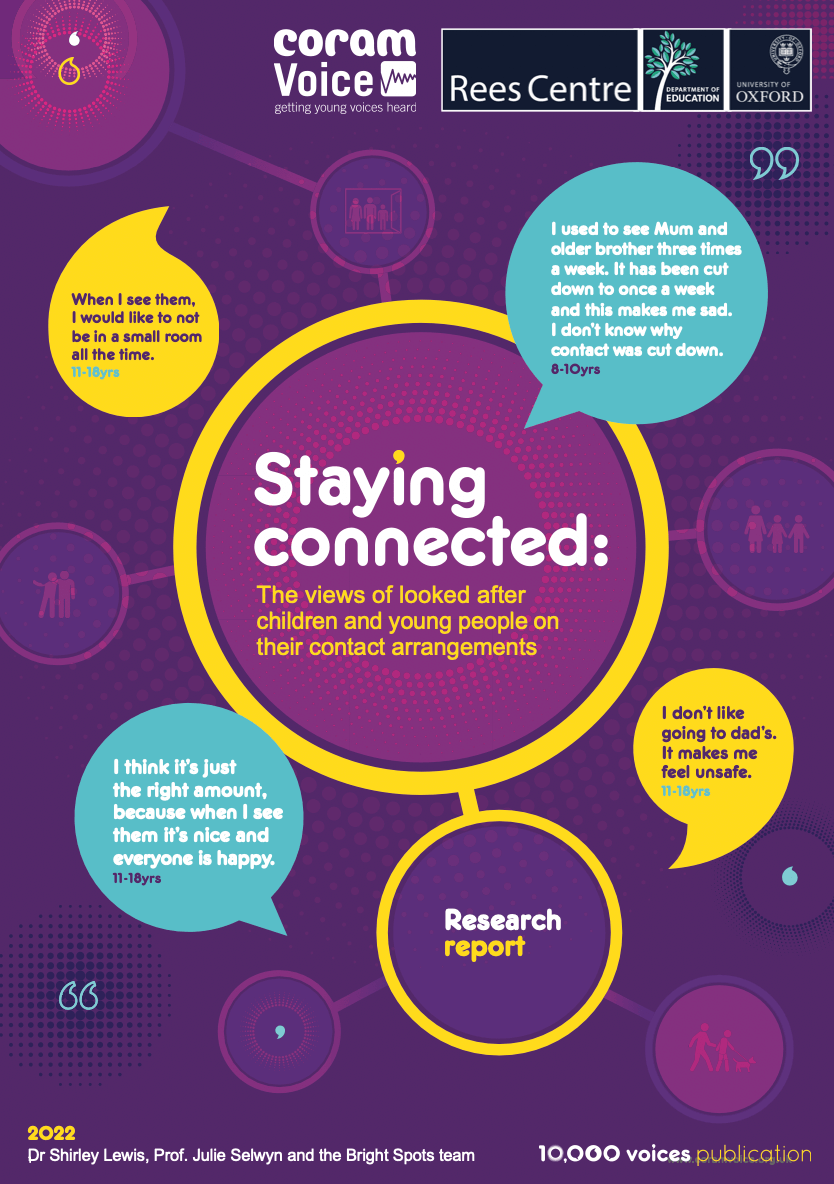
Summary
Over 7,500 children and young people in care share their views and experiences on contact arrangements with their families.
The views and experiences of over 7,500 children and young people in care on their contact with family members and impact on their wellbeing are uncovered in a new report published today by Coram Voice and The Rees Centre at University of Oxford*.
Staying Connected finds that nearly a third (31%) of children (aged 8-10) and a quarter (25%) of young people (aged 11-18) felt they were seeing their mothers too little, whilst over a fifth (22%) of children and 18% of young people felt they were seeing their fathers too little. 22% of children didn’t feel they had enough contact with their brothers and sisters, and this figure was higher for young people (31%). About one in five young people had no contact with either parent and this was particularly the case for those in residential care and boys.
Visits being arranged at inconvenient times, long distances, the costs of travel, their family’s circumstances, and workers failing to make necessary arrangements were among reasons cited by children and young people for seeing family less often than they wanted. Children in care who felt they saw family members too little reported feeling sad, angry and unsettled, while in contrast, those who felt contact arrangements were “just right” felt they were being listened to and looked forward to seeing their family.
One young person (aged 11-18) commented: “I want to see my family more. My social worker is supposed to be doing police checks. I have been here since September and the checks have not been done. It’s not like I can just visit. I live five hours from home.”
Whether children and young people felt that they saw parents often enough was statistically associated with length of time in care, type of placement and which local authority was caring for them. Analysis shows that young people (aged 11-18) in residential care more frequently reported that they had too little contact with family compared to young people in other types of placements. The number of placements experienced also had an impact, with 60% of young people who had only had one placement reporting they were satisfied with their contact frequency, compared to 39% who had experienced 11 or more placements.
In addition, 50% of young people surveyed did not feel involved in decisions social workers made about their lives, and half of the comments about involvement focused on contact arrangements. Children and young people commented on arrangements being inflexible, not changing as they got older or as their family’s circumstances changed. One child (aged 8-10) commented: “I used to see Mum and older brother three times a week. It has been cut down to once a week and this makes me sad. I don’t know why contact was cut down.”
Linda Briheim-Crookall, Head of Policy and Practice Development at Coram Voice, said: “The recent Care Review suggested the primary objective of the care system should be promoting the formation of lifelong loving relationships around children in care and care leavers. This can only be achieved if more is done to build rather than break relationships with the people who are already important to children in care. Our research showed that there is still some way to go to make this happen.
“Services and workers must listen to children and young people about who they want to see, when and how and seek to make this happen. Children in care should have the opportunity to spend time with the people who are important to them doing everyday things like playing games, having a meal or going for a walk with the dog.”
Julie Selwyn, Professor of Education and Adoption at The Rees Centre at University of Oxford, said: “While previous UK research has emphasised that the quality of contact is more important than the frequency, from young people’s perspective frequency was equally, if not more important. Feeling contact was ‘just right’ was associated with higher levels of wellbeing. Staying connected to the important people in life is essential for children’s wellbeing. Greater efforts need to be made to ensure that this is achieved for all children in care.”